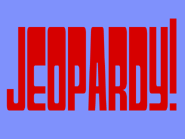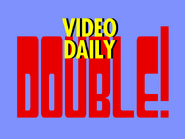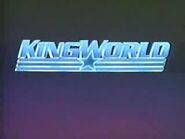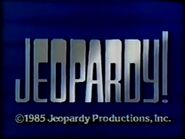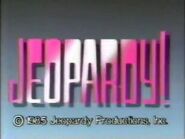| 01 | 02 | 03 | 04 | 05 | 06 | 07 | 08 | 09 | 10 |
| 11 | 12 | 13 | 14 | 15 | 16 | 17 | 18 | 19 | 20 |
| 21 | 22 | 23 | 24 | 25 | 26 | 27 | 28 | 29 | 30 |
| 31 | 32 | 33 | 34 | 35 | 36 | 37 | 38 | 39 | 40 |
Season 1 (1984-1985)[]
Season changes:
- The neon bands of the Jeopardy! set became white, maroon, and blue with the contestant podiums being updated to match. The orange Jeopardy! lettering became red. The carpet became blue, while the studio backdrop became red. Also, the clue board became a white frame. The show's logo is redesigned to the Gyparody font, as seen on the set. The nine-foot neon letters now stay permanently lit throughout the whole show.
- This is the only season to use the 1984-1985 set.
- This is also the only season to not have any tournaments.
- This is the first season where Alex didn't wear any glasses.
- This is also the first season where Alex stands in front of a game board, when the Final Jeopardy! category is revealed on the monitor. This remained in use until Season 27, when Alex began sitting at his podium in Season 28.
- The contestants names don't appear onscreen, and the winning graphic flashes onscreen.
- This is the first season, in which the show aired for 195 half-hour episodes.
- The podium microphones from the second pilot, the modular AKG C451E w/VR-1 extensions, are carried over.
- This is also the first season, in which the closing credits appear in white Korinna font, the same font used for the clues. This remained in use until Season 12 (1995-1996). This is the first season where Mr. Guy is credited as Alex Trebek's wardrobe provider.
- Starting with the syndicated version the show, the main theme song is a rendition of "Think!".
- The original version of the main theme consists of synthesizers and saxophones.
- The first Final Jeopardy! "Think" music is carried over from the 1964-1975 daytime version hosted by Art Fleming, and would remain in use until the end of Season 13.
- This is the first season to be produced by Merv Griffin Enterprises, which continued to be produced until Season 10 (1993-1994).
- Metromedia Square in Hollywood became the first taping location for this incarnation of Jeopardy!.
- At the beginning of the Jeopardy! and the Double Jeopardy! round segments, each of the following monitors displayed a red Jeopardy! logo on a light blue background in Double Jeopardy!, this graphic features white text reading "DOUBLE" in Futura above the Jeopardy! logo. These graphics dissolve with a whoosh sound, and then, the dollar amounts pop in one by one, accompanied by ascending and descending musical beeps.
- The original loading pattern and sound effect remained in use until the end of Season 24.
- Additionally, the dollar amounts began to display on a blue background.
- The categories in the Jeopardy! segment now have clues worth $100 to $500 in $100 increments.
- The Double Jeopardy! segment, these amounts are doubled to $200 to $1,000 in $200 increments.
- The Daily Double card is completely redesigned. The word "DAILY" changed its color to yellow in Futura and it now consists of a red "DOUBLE!" in the Gyparody font. The background changes to a brighter blue.
- There are now also separate cards for Audio Daily Doubles.
- The word "AUDIO" is added on top of a shrunken "DAILY", but the rest of the logo remains unchanged.
- The categories are backlit up on cards with red text bordered by red neon lights which stay on permanently.
- The contestants make their Final Jeopardy! wagers during the commercial break, after the category is revealed and before the clue is revealed.
- The contestants' names now appear in the podium monitors. The Daily Double sound effect is changed to a whooshing sound. The end of round sound effect is changed to ten low-pitched beeps. The sound effects are now generally electronic.
- Each episode began with a shot of an empty set, while Johnny said "This is Jeopardy!", and the studio audience can be heard chattering in the background before the show starts. After that, the studio audience stopped chattering, and the Jeopardy! theme starts playing, while a blue Jeopardy! globe graphic fades in.
- A ticket and contestant plug is shown during the second commercial break.
- Alex enters with a microphone in his hand, but during the first week, Alex wore a clip-on microphone.
- The onscreen display text for the Final Jeopardy! clue changed its color back to yellow as in Pilot 1, and initially only appears when the second verse of the "Think" music plays.
- The sponsor list, eligibility disclaimer, credits, and copyright notice are initially displayed in Korinna.
- The sponsor list initially begins with "THE FOLLOWING HAVE PAID AND OR FURNISHED PRIZES TO THE PRODUCTION COMPANY FOR PROMOTING THEIR PRODUCTS", please note the omission of the slash between AND and OR, and the first eligibility disclaimer is "PRIZE WINNERS MUST MEET ELIGIBILITY REQUIREMENTS".
- The wardrobe provider credit reads "Alex Trebek's Wardrobe furnished by MR. GUY of Beverly Hills".
- Initially, Merv Griffin's creator credit appears for the first time in the closing credits list.
- Alex is the first producer for Jeopardy!, and he would remain in use until 1987, when George Vosburgh took over as producer.
- The syndicated version's first director is Dick Schneider, who remains as director for the show's first eight seasons, until his associate director, Kevin McCarthy took over as director in 1992.
- Other prominent members of the first syndicated Jeopardy! production team include production executive David S. Williger, production manager Jack Reynolds, stage manager Keith Richmond, lighting director Vincenzo Cilurzo, and technical directors Dave Bachman and Vince Mack.
- The first writing supervisor is Jules Minton who is labeled as an "Answer & Question Supervisor".
- The first production crew consisted of Steven Dorfman, Harry Eisenberg, Barbara Heller, Michele Vaughn Johnson, Gary Lee, and Suzanne Stone.
- Authentication of materials is initially provided by encyclopedia publisher World Book.
- At this point, Merv Griffin has expanded his company as Merv Griffin Enterprises. To reflect this, Johnny's catchphrase is changed to "Jeopardy! is a production of Merv Griffin Enterprises, distributed by KingWorld".
- In the Merv Griffin Enterprises logo, the griffin now winks at the camera, and the text is animated.
- The KingWorld logo is changed to a new "Stars and Stripes" design, which features the name in Serpentine Italic, with a set of three bars underneath and a star in the middle of them. Also, there was a small white text above it reading "Distributed by". This is followed by a copyright/title screen which fades out along with the closing theme music.
- The original copyright card shows the Jeopardy! name in all caps Gyparody lettering with a white blue red border, on a sky blue background. The original copyright notice is in blue Korinna font, and reads "(c) 1984 All Rights Reserved.", with no copyright holder named. But on later episodes of this season, the text read "(c) 1984 JEOPARDY PRODUCTIONS, INC." in Serif Gothic font.
- Although not mentioned on the air, the show has a winnings limit of $75,000 (in addition to having an appearance limit of five shows), with any winnings exceeding that amount being donated to a charity of the contestant's choice.
This season:
- Jeopardy! made its syndication debut on September 10, 1984, and Alex Trebek became the program's host, where he is joined by Johnny Gilbert as the show's announcer. Before the Trebek version debuted in 1984, Johnny Gilbert began his career in radio. He was the announcer for game shows, and he was also a singer. On the series premiere episode Greg/Lois/Frank, Greg Hopkins became the first returning champion on Jeopardy! to win $8,400. The theme song plays in a repeated loop from 1:16 to 1:44 during the consolation prize segments, and during the closing credits. On this episode:
- The categories in the Jeopardy! round segment consisted of the following: "Lakes & Rivers", "Inventions", "Animals", "Foreign Cuisine", "Actors & Roles", and "Number, Please".
- The first clue that Alex answered in the "Animals" category is "These rodents first got to America by stowing away on ships", and the first correct response is "What are rats?". The second clue that Alex answered in the same "Animals" category is "There are about 40,000 muscles & tendons in this part of an elephant's body", and the second correct response is "What is the elephant's trunk?". The third clue that Alex answered in the "Actors & Roles" category is "Video in which Michael Jackson plays a werewolf & a zombie". The correct response is "What is Thriller?".
- The categories in the Double Jeopardy! round segment consisted of the following: "The Bible", "'50s TV", "National Landmarks", "Weights & Measures", "Notorious", and "4-Letter Words".
- The first Final Jeopardy! category that Alex revealed at the end of this episode is "Holidays".
- On the September 11, 1984 episode (Greg/Lynne/Paul), all three contestants end the game with $0, the first occurence in the Alex Trebek\ era. Each contestant lost that day's Final Jeopardy! and wagered their entire earnings. Alex nearly forgets to reveal the correct response until someone reminds him offstage. The Final Jeopardy! clue was "Calendar date with which the 20th century began"; the correct response was "What is January 1, 1901?". The contestants‘ incorrect response, "What is January 1, 1900?” was actually the first day of the first decade of the 20th century and the first day of the last year of the 19th century; three new players would appear on the next show.
- On the September 12, 1984 episode (Gunther/Nancy/Michael), Michael became the first contestant in the Alex era to be disqualified from playing Final Jeopardy! due to finishing Double Jeopardy! with -$1,300.
- On the October 4, 1984 episode, Elise Beraru wins $23,800, a record which would stand until the following year.
- On the October 5, 1984 episode, Elise Beraru became the first five day Jeopardy! champion of the Alex era, winning $47,350.
- By the November 26, 1984 episode:
- The neon letters now flash off one by one in order from left to right during the introduction, the closing and goes into and comes out of commercial breaks.
- The backlit on the category card turns off when all the clues have been read.
- The Daily Double sound effect is changed back to the warbling siren used in Pilot 2 but slightly longer.
- The end-of-round sound effect is changed to sixteen high-pitched beeps, eight of which are heard twice.
- The ring-in sound is not used.
- The whoosh sound at the start of the Double Jeopardy! segment mutes out, and the dollar figures simply pop in.
- The onscreen display of the Final Jeopardy! segment now appears about 10 seconds sooner than it did originally.
- The copyright notice is changed to Futura, and "All Rights Reserved" is changed to the copyright holder name "Jeopardy Productions, Inc." in uppercase letters.
- On the December 4, 1984 episode, Richard Landon, who won four games a week prior, is brought back due to an error on his original fifth appearance aired November 27, 1984.
- The episode aired on March 12, 1985, which has Steve Rogitz as the champion, and it has a full credit roll. During the closing credits, a camera zooms into Rogitz and then zooms back out.
- Also by the March 15, 1985 episode:
- The neon lights now flash considerably faster.
- The whoosh sound is not used in the opening, but it is still heard at the start of the Jeopardy! segment when the dollar values pop in.
- The globe logo during the opening credits now flies toward the screen. The letters in the logo changed its color to red.
- The closing KingWorld logo is changed to a more elaborate animated version against a purple gradient background, without the "Distributed by" text.
- The logo is changed to light blue, while the rays are crossed about and the company name slides in and zooms away, while the star moves from the viewer and the bar draws under the company name and the left and right of the star.
- The copyright card is changed to blue with a large silver Jeopardy! logo.
- The copyright notice is changed to white Helvetica sentence case text, and now takes up one line instead of two.
- On the April 12, 1985 episode, Mike Day is the only contestant to play Final Jeopardy! in his fourth game, the first occurrence of a solo Final Jeopardy! in the syndicated history of the game show.
- Season 1 of Jeopardy! wraps up on June 7, 1985.
- Summer reruns air from June 10-September 6, 1985, with reruns later airing on weekends from 1985-1986.




